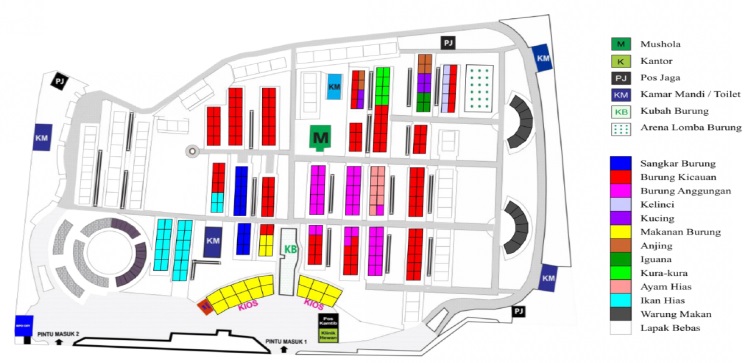Designing Animal Market Layout by Considering Consumer Purchase Behaviors
DOI:
https://doi.org/10.12928/si.v22i1.164Keywords:
Layout planning, Association rules, Market basket analysis, animal marketAbstract
Sales transaction data contains rich information and can support company competitiveness. However, this transaction data is initially unstructured and needs to be processed into insight for the company's decision-making. Market Basket Analysis (MBA) is a data mining technique that can be used to study consumer purchasing patterns. This paper presents a case study on using an MBA to obtain consumer buying behaviors where the result of the MBA is then used to design a proposed layout. The animal market governed by Yogyakarta Province, known as Pasty Market, was used as a case study. Pasty Market is an animal trading center with around 30,000 square meters area and 255 sellers that sell various kinds of animals such as songbirds, dove birds, rabbits, cats, dogs, iguanas, turtles, ornamental chickens, and ornamental fish as well as animal food and cage. With this enormous area and number of merchants, the layout of Pasty Market becomes crucial in customer satisfaction. Association rules result in four priority levels in proposed layout planning, where these rules are used to determine the proximity among items in the proposed layout. These four levels of priority, ordered by the confidence value, are (1) “songbirds” and “bird food” (confidence value 91%), (2) “ornamental fish” and “turtles” (confidence value 80-90%), (3) “birdcages” and “songbirds” (confidence value 70-80%), and (4) “cats” and “dog” as well as “birdcages” and “birds” (confidence value 50-70%). Association rules were then used as the basis for determining the proximity value between merchants, where the proximity rules were then used for designing a proposed layout.
References
Ali Naqvi, S. A., Fahad, M., Atir, M., Zubair, M., & Shehzad, M. M. (2016). Productivity improvement of a manufacturing facility using systematic layout planning. Cogent Engineering, 3(1), https://doi.org/10.1080/23311916.2016.1207296.
Bermudez, J., Apolinario, K., & Abad, A. G. (2016). Layout optimization and promotional strategies design in a retail store based on a market basket analysis. In 14th LACCEI International Multi-Conference for Engineering, Education, and Technology, https://doi.org/10.18687/LACCEI2016.1.1.307.
Dhanabhakyam, M., & Punithavalli, M. (2011). A survey on data mining algorithm for market basket analysis. Global Journal of Computer Science and Technology, 11(11), 23-28, https://computerresearch.org/index.php/computer/article/view/788.
Gupta, M. K., & Chandra, P. (2020). A comprehensive survey of data mining. International Journal of Information Technology, 12(4), 1243-1257, https://doi.org/10.1007/s41870-020-00427-7.
Jain, S., Sharma, N. K., Gupta, S., & Doohan, N. (2018). Business Strategy Prediction System for Market Basket Analysis. Springer Proceedings in Business and Economics, 93–106, https://doi.org/10.1007/978-981-10-5577-5_8.
Kaur, M., & Kang, S. (2016). Market Basket Analysis: Identify the Changing Trends of Market Data Using Association Rule Mining. Procedia Computer Science, 85(Cms), 78–85, https://doi.org/10.1016/j.procs.2016.05.180.
Kurnia, D. N. H., & Lestari, Y. D. (2021). Determination of Alternative Retail Layout using Market Basket Analaysis. The 3rd International Conference on Business and Banking Innovations (ICOBBI), 260–264, https://eprints.perbanas.ac.id/6478/.
Kurniawan, F., Umayah, B., Hammad, J., Nugroho, S. M. S., & Hariadi, M. (2017). Market Basket Analysis to Identify Customer Behaviours by Way of Transaction Data. Knowledge Engineering and Data Science, 1(1), 20, https://doi.org/10.17977/um018v1i12018p20-25.
Mostafa, M. M. (2015). Knowledge discovery of hidden consumer purchase behaviour: a market basket analysis. International Journal of Data Analysis Techniques and Strategies, 7(4), 384-405, https://doi.org/10.1504/IJDATS.2015.073867.
Musungwini, S., & Zhou, T. G. (2014). An investigation of the role of product, place, promotion and price (4Ps) in market basket analysis: a case study of retail shops in Gweru Zimbabwe. International Journal of Science and Research, 3(2), 132-135, https://www.ijsr.net/getabstract.php?paperid=2013897.
Nurmayanti, W. P., Sastriana, H. M., Rahim, A., Gazali, M., Hirzi, R. H., Ramdani, Z., & Malthuf, M. (2021). Market basket analysis with apriori algorithm and frequent pattern growth (Fp-Growth) on outdoor product sales data. International Journal of Educational Research and Social Sciences (IJERSC), 2(1), 132-139, https://doi.org/10.51601/ijersc.v2i1.45.
Panjaitan, S., Sulindawaty, Amin, M., Lindawati, S., Watrianthos, R., Sihotang, H. T., & Sinaga, B. (2019). Implementation of Apriori Algorithm for Analysis of Consumer Purchase Patterns. Journal of Physics: Conference Series, 1255(1), https://doi.org/10.1088/1742-6596/1255/1/012057.
Priyanto, J., Lahay, I. H., & Junus, S. (2019). Perancangan Ulang Tata Letak Pasar Tradisional dengan Metode Market Basket Analysis. Seminar Nasional Teknologi, Sains Dan Humaniora (SemanTech), 261–268, https://jurnal.poligon.ac.id/index.php/semantech/article/view/481.
Putra, A. P., Alma, A. D. B., Ardelia, A. S., Bagaswara, B., & Habsari, D. S. W. (2022). Relayout Supermarket X Menggunakan Metode Market Basket Analysis dan Blocplan. Seminar Dan Konferensi Nasional IDEC, B22.1-B22.9, https://idec.ft.uns.ac.id/wp-content/uploads/IDEC2022/PROSIDING/ID097.pdf.
Qisman, M., Rosadi, R., & Abdullah, A. S. (2021). Market basket analysis using apriori algorithm to find consumer patterns in buying goods through transaction data (case study of Mizan computer retail stores). ICW-HDDA-X 2020, 1722(1), 1–13, https://doi.org/10.1088/1742-6596/1722/1/012020.
Rusnandi, Suparni, & Pohan, A. B. (2020). Penerapan Data Mining untuk Analisis Market Basket dengan Algoritme FP-Growth pada PD Pasar Tohaga. Jurnal Nasional Pendidikan Teknik Informatika: JANAPATI, 9(1), 119–133, https://doi.org/10.23887/janapati.v9i1.19349.
Tarigan, U., Tarigan, U. P. P., Rahman, I. H., & Rizkya, I. (2018). Design of facility layout with lean service and market basket analysis method to simplification of service process in the supermarket. MATEC Web of Conferences, 197, 0–4, https://doi.org/10.1051/matecconf/201819714006.
Wahyudi, I., & Anwar, A. (2022). Perbaikan Tata Letak Pasar Induk Tradisional di Sangatta dengan Metode Market Basket Analysis (MBA). Research Journal of Accounting and Business Management, 5(2), 113, https://doi.org/10.31293/rjabm.v5i2.5784.
Widodo, I. D., Ulfah, H., & Anggraeni, K. N. (2021). Redesign Super Market Layout Analysis Based on Hidden Customer Purchase Behaviour. 2021 IEEE 8th International Conference on Industrial Engineering and Applications, ICIEA 2021, 261–264, https://doi.org/10.1109/ICIEA52957.2021.9436714.
Yul, F. A., & Mulyati, S. (2022). Implementasi Metode Market Basket Analysis pada Penataan Ulang Tata Letak Pedagang Pasar Arengka di Kota Pekanbaru. Jurnal Surya Teknika, 9(2), 525–531, https://doi.org/10.37859/jst.v9i2.4305.

Downloads
Published
How to Cite
Issue
Section
License
Copyright (c) 2024 Danang Setiawan

This work is licensed under a Creative Commons Attribution-ShareAlike 4.0 International License.









.png)




